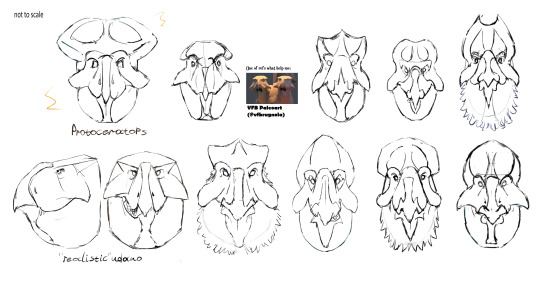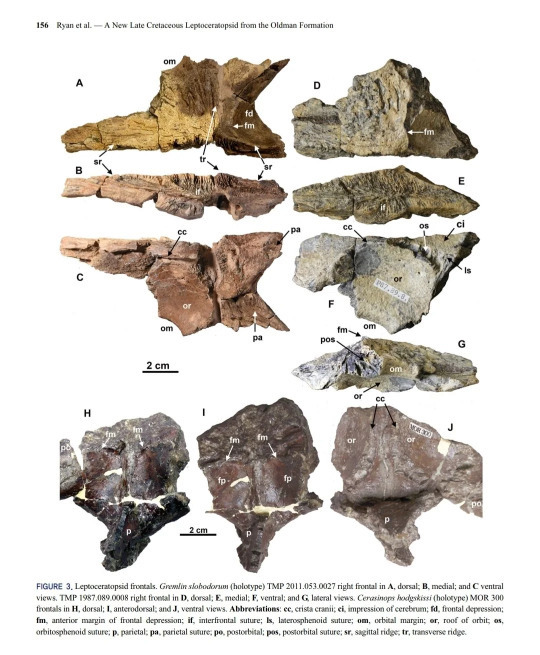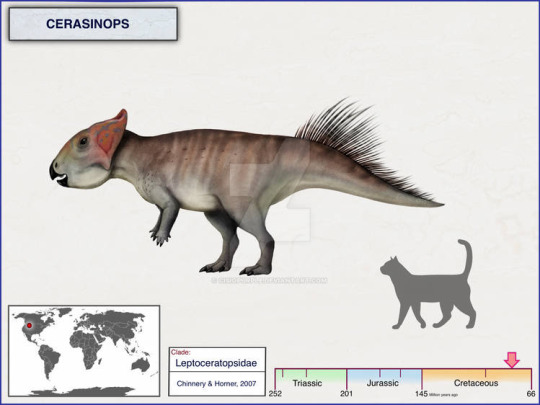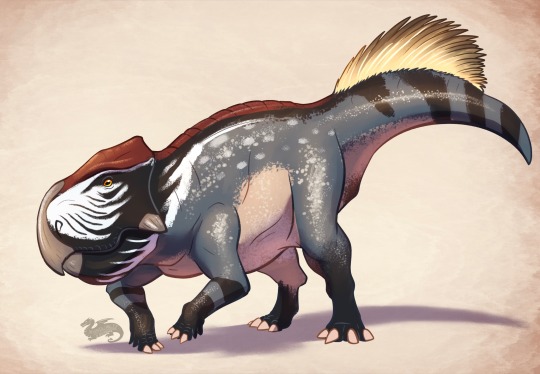#Leptoceratopsid
Text

#Archovember Day 27 - Udanoceratops tschizhovi
The leptoceratopsids are known for being small, pig-sized Late Cretaceous ceratopsians reminiscent of their more basal ancestors. But Udanoceratops tschizhovi took things to the next level, growing to the size of a hippopotamus, with the head and jaw strength to match. While assumed to be a herbivore like other ceratopsians, little is known about plants that grew in the Gobi Desert at the time of the Cretaceous, so it is unclear what types of plants it would have eaten. Its sharp beak, powerful jaws, and shearing/crushing teeth suggest a diet of relatively tough plants. Like other ceratopsians, particularly leptoceratopsians, Udanoceratops could have also opportunistically scavenged carcasses, nests, or even small mammals and young/weak dinosaurs for extra protein in its desert environment.

In the Djadochta Formation of Mongolia, Udanoceratops would have lived alongside the smaller, more numerous protoceratopsians Protoceratops and Bagaceratops. This was a mostly barren landscape, likely dotted by oases and arroyos that would have attracted smaller animals like nanhsiungchelyid land turtles, lizards like Gobiderma, frogs like Gobiates, crocodylomorphs like Artzosuchus, small mammals like Asiatherium and Mangasbaatar, and small theropods like the oviraptorosaur Avimimus. Udanoceratops was the largest animal around. Thus far, no predators large enough to take on an adult Udanoceratops have been found in its locality. The dromaeosaur Velociraptor could have snatched a baby Udanoceratops when the opportunity arose, but it would then risk the ire of this giant desert hippo with a staple remover for a head.
#my art#SaritaDrawsPalaeo#Udanoceratops tschizhovi#Udanoceratops#Leptoceratopsid#neoceratopsians#ceratopsians#ornithischians#dinosaurs#archosaurs#archosauromorphs#reptiles#Archovember#Archovember2023
30 notes
·
View notes
Note
what’s Gremlin?
Gremlin slobodorum is a new leptoceratopsid ceratopsian from the Oldman Formation of the Late Cretaceous of North America.


It is not known from GOOD remains... but it has an excellent name.
354 notes
·
View notes
Text
Various Udanoceratops

I started drawing 'em on October 30. I had to draw something Halloween, and found this dinosaur. This early ceratopsian is a giant leptoceratopsid. Its large jaws fragments strikes imagination - skull looks like Jack O Lantern in flesh
These folks are striped with bright heads because they're huge and conspicuous. The feather coat from sparse bristles has been transformed into a mane along the spine because it looks much more authentic and even realistic. The rest of shagginess - on jaw and paws - is the transition form between the scales and (proto)feather. Many have a lower beak down the chin - this depicted not only in reconstructions, but I also noticed it in fossils of P. hellenikorhinus. It plays role of a lips and even beard (just like upper), and having a light color adds volume and old age at the same time.

For experiment i drew em in frontal. There is no picture/diagram on Internet where fossils can be viewed from other angles except profile. Anyway, I gave everyone binocular vision, because that’s basic thing for (small) Neoceratopsia. I use some 3D references and Protoceratops anatomy.
I drew these Udanoceratops earlier, and here they have slight frills that aren't wider than jugal/zygomatic/cheek horns.
118 notes
·
View notes
Text
Gremlin slobodorum Ryan et al., 2023 (new genus and species)

(Type frontal [bone in the top of the skull] of Gremlin slobodorum, from Ryan et al., 2023)
Meaning of name: Gremlin = gremlin [creature in 20th-Century folklore blamed for aircraft malfunctions]; slobodorum = for Ed and Wendy Sloboda [contributors to paleontological discoveries in Alberta, the latter of whom discovered the original fossil]
Age: Late Cretaceous (Campanian), between 76.7–77 million years ago
Where found: Oldman Formation, Alberta, Canada
How much is known: A partial right frontal (bone in the top of the skull).
Notes: Gremlin was a leptoceratopsid ceratopsian. Unlike the better known ceratopsid ceratopsians (such as Triceratops), leptoceratopsids were relatively small (mostly around sheep-sized) and lacked horns. Although it is very incompletely known, Gremlin can be distinguished from other leptoceratopsids by the presence of a ridge running across the top of each frontal ("tr" in the figure above). It also fills a gap in time in the fossil record of leptoceratopsids in Alberta, being intermediate in age between the older Gryphoceratops from the Milk River Formation and the younger Unescoceratops from the Dinosaur Park Formation.
Reference: Ryan, M.J., L. Micucci, H. Rizo, C. Sullivan, Y.-N. Lee, and D.C. Evans. 2023. A new Late Cretaceous leptoceratopsid (Dinosauria: Ceratopsia) from the Oldman Formation (Campanian) of Alberta, Canada. Pp. 151–165, in Y.-N. Lee (ed.), Windows Into Sauropsid and Synapsid Evolution. Dinosaur Science Center Press, Seoul.
94 notes
·
View notes
Text
So a new species of dinosaur was just discovered and uh……. They named it Gremlin. Gremlin slobodorum…….

So Gremilin slobodorum is a species of leptoceratopsid ceratopsian dinosaur that lived during the Campanian stage of the Cretaceous period around 77 million years ago. Its fragmentary remains were first found in the Oldman Formation in Alberta, Canada and were originally thought to have belonged to a different genus of small ceratopsian called Cerasinops since their remains have been found in rock layers around that same age.

(Cerasinops compared to a modern house cat. Art by cisiopurple on Deviantart)
However, it was just recently discovered to be a completely new genus and so it was given the name: Gremlin slobodorum. The genus name “Gremlin” obviously refers to the mischievous mythical creature while the species name “slobodorum” is in honor of Ed and Wendy Sloboda who were both involved in the discovery of the holotype specimen.
If I’m being honest I don’t really like the genus name of this dinosaur. Like I’m all for extinct creatures having names inspired by mythology but just calling it Gremlin feels lazy in my opinion. Like it does look like a Gremlin but maybe Gremlinsaurus or Gremlinceratops would’ve been better names. But despite its uncreative (in my opinion) name I still think it’s a pretty cool dinosaur and can’t wait for more paleo art of this guy to start popping up. Also, no hate to the people who named this genus or if you like the name. I just wish it wasn’t just called Gremlin. Who knows maybe the name will grow on me.
#paleontology#dinosaur facts#new discoveries#new species#new dinosaur#animals#science#dinosaur#gremlin#gremlincore#unintelligible gremlin noises#nature facts#dinosaur love#i just want some way to be able to tell when people are talking about the dinosaur and when they’re talking about the mythical creature
45 notes
·
View notes
Text


#spectember: Day 1 Oldest Spec Creature
My first creature wasn't spec evo, so I decided to make the Banderosa Drake a lion like leptoceratopsid, the first entity I posted, here a female is on alert, while a male lazily lays down after a hunt and his cub plays with a scarab
20 notes
·
View notes
Text




Quick colored sketch I made a little while ago of the newly described Gremlin slobodorum, a particularly fragmentary Leptoceratopsid.
12 notes
·
View notes
Text

Paleovember 2022, Udanoceratops!
Living in Late Cretaceous Mongolia, Udanoceratops is the largest of a group of characteristically small ceratopsians called leptoceratopsids, measuring about 13 feet long. While it's frill was quite short, it's lower jaw on the other hand is massively robust, pointing to a diet of especially tough vegetation and a wickedly powerful defense with such a huge bite force.
#Udanoceratops#ceratopsian#triceratops#dinosaur#paleontology#paleoart#illustration#art#cretaceous period#artwork#procreate#mongolia#artist on tumblr
62 notes
·
View notes
Text
While the Prehistoric Planet hype is still alive, I might as well express my desire for more and say what I'd personally love to see if they did a Season 3. I’ll put this under the cut because it’s a lot lol.
First thing's first, I'm going to be operating under the assumption we will be following the same format and setting, ie a few segments per episode set in the Masstrichtian stage of the Cretaceous with some loose overarching theme. I need to keep myself grounded in SOMETHING.
So first thing: I've already made fun of "North America" being the title of episode 2.5. What would fix this? If Season 3 did episodes centred on the other continents, of course! South America, Africa, Asia, Europe and... oh uh this might be a bit trickier. Specifically, where do Oceania and Antarctica go? Honestly, just do a vague "East Gondwana" episode for Madagascar, India, Antarctica and Zealandia.
"But we never saw anything from Appalachia!" True. Some generic "Islands 2" or "subcontinents" episode? But Antarctica isn't a subcontinent... maybe some "Atlantic" episode to combine with the European islands? Point is, it would still be messy. This isn't even my main idea, just a vague thought on how to structure Season 3 plus being salty that America gets its own episode (there weren't even any Canadian creatures lol).
OKAY enough fucking around, let's get to what I actually WANT to talk about, the stuff I'd actually want to see. Bring on the list!
Megaraptorids. We've seen representatives of all the large predatory theropods... except megaraptorids. A strange unique group of predators we don't even know where they fit in dinosaur cladistics, but seemed to be important in South American ecosystems. Orkoraptor actually comes from the same place as Dreadnoughtus so there's an easy excuse already, but I think it would be even more exciting to consider Maip. The size of this thing pretty much confirms they were apex predators, so definitely worth considering.
More notosuchians. It's wild how diverse they were, Simosuchus is just one of many species worth showing. Might as well mention Baurusuchids in particular, especially since they seem to have become significant predators in parts of South America. Dinosaur hunting crocs, guys.
Honestly? I'm down for crocodyliformes in general. Show us dyrosaurs in the seas, and even Eusuchians. Similar to modern crocs like Shamosuchus in Swamps, or something different like the more terrestrial Allodaposuchus.
More Europe weirdness! Whether it be Hateg fauna or stuff we know from other parts of the continent, I think people don't realise how unusual those ecosystems were, especially compared to Laurasia in general. Maybe I just want to see Magyarosaurus in detail, but also think about how Abelisaurs seem to be prominent terrestrial predators, for example? Also all the strange birds like Gargantuavis and maybe Balaur. Also, Asteriornis I see a lot of hype for. ;P
On a similar note, more stuff from Africa could be nice, especially terrestrial fauna! We know dinosaurs from Ouled Abdoun, which had fauna featured in Coasts and Deserts, and it's worth considering especially because you kind of see how some of these animals' ancestors may have led to similar species in nearby Europe. Also, if they ever further described more remains from the continent like that giant Kenyan abelisaur, that could provide cool opportunities.
This is a bit more out of left field but: non-ceratopsid ceratopsians. Leptoceratopsids, and even Protoceratopsids (hey, we have Velociraptor, we can make that stretch). Show how they're different from say Triceratops.
More non-hadrosaur ornithopods. Whether it be Thescelosaurus, more rhabdodontids, or some good ol Elasmarians from the Southern continents, I'd be down.
More India stuff is always fun, Deccan Traps FTW, could show other animals like noasaurs for that matter too.
Also Parankylosaurs, whether it be Stegouros with the macuahuitl, or an updated Antarctopelta (more Antarctica FTW).
Basically, even in terms of dinosaurs, show more stuff you've yet to do. Nodosaurs, Halzkaraptorines (again, see Velociraptor), heck even more of some groups we only briefly saw eg Alvarezsaurs and Pachycephalosaurs.
Honestly? More birds would be cool in general. I know we don't know much about a lot of them like Enantiornithines, but we could still try showing what we do know.
In terms of more familiar and recognisable stuff? I mean, you can't go wrong with well known species, but this is me wishing for stuff that's new. :P I will say though, if you want big names, we still haven't seen Ankylosaurus or Gallimimus...
Hmm, we haven't seen choristoderes, have we? In terms of other reptiles, not much comes to mind, nice we got to see Madtsoia in Islands at least.
Honestly more mammals could be fun. I'm pretty sure we have members of every modern group from the Maastrichtian somewhere (even monotremes, Patagorhynchus was recently described). Also diversity of lifestyles too.
Appalachia. More North America, but we see how life evolved somewhat differently on the eastern side of the continent and how it likely lacked some of the more recognisable animals we know from Laramidia.
I don't know enough about other groups to comment, so I'll leave it at that. Definitely got quite extensive, but honestly I'm all for exploring new places. Hell, look into invertebrates and fish I know heck all about (hmm I'm sure there's some cool sharks, right?).
Anyway, time to address the elephant in the room. What if the next season left the Maastrichtian, or we got a spin-off that did that? Well, I do have thoughts on that. For that, I could easily be SUPER biased and just name stuff that I personally want to see, but I think you'd need to think from the perspective of the higher ups too. In other words, what's gonna get the most eyes on the show? There's that, and also how well known the information of that time is, as well as considering things like cost and practicality. The Maastrichtian was chosen because it filled all three of those needs. You have iconic and charismatic species like T. rex, the Maastrichtian is very well studied and has sites from almost every continent, and because it's the closest to today, it's the easiest to film for.
I don't really know anything that would fit these three needs perfectly, ESPECIALLY in terms of filming locations (unless they wanna go majority CG, which I wouldn't mind personally but I know the production team likes real locations because of what they add to the show). But anyway, I have two possible eras as my main choices if they choose to do a similar kind of show: the Late Jurassic epoch (I'd name a specific stage but I don't know enough about them lol), and the Cenomanian stage at the start of the Late Cretaceous.
For the Late Jurassic (insert chosen stage of it here), you have a lot to work with. You have all the other most iconic traditional staple dinosaurs like Stegosaurus, Brontosaurus, Brachiosaurus and well known contemporaries like Diplodocus, Allosaurus, etc. In fact, the Morrison Formation is the main reason I opted for a Late Jurassic option. Sure, it does cover quite a bit of time, but we've seen Prehistoric Planet already take liberties with a six million year time span.
I think my main worry would be that some of the ecosystems on different continents might seem a bit similar, but honestly I doubt anyone would care too much. Plus, you have Asia with slightly different dinosaur groups, and Europe with their island ecosystems (eg Solnhofen). So even if it would be harder to film and some of the best locales for data are in more concentrated areas, I think there's enough to justify it. Also, novelty of early birds and birdlike dinos like Archaeopteryx.
As for the Cenomanian, you already have an easier time filming because angiosperms are now widespread, and you do have data from every continent. And while it doesn't have so many iconic species, there are a few, and some very charismatic animals to explore. Like, you have some of the biggest titanosaurs like Argentinosaurus. Massive Giganotosaurins who are built for hunting large sauropods. Everyone's favourite dinosaur, Spinosaurus. And again, stuff from almost every continent. Like, you could even have freaking Australia show up! Winton Formation is Cenomanian, so it could join the showcases of Africa, South America and others (I don't know so much about Cenomanian Laurasian fauna RIP). And while it would be true for the Late Jurassic as well, this time had especially peculiar nondinosaurs coexisting. Strange mammals. Giant freshwater fish. More unusual crocs. Even the earliest mosasaurs, all while ichthyosaurs and pliosaurs still existed. Basically, even if a layperson might only know Spinosaurus and Giganotosaurus from this time, you still have loads to potentially awe people with.
Anyway, that's a wrap on that. I have no clue what to expect for the future of Prehistoric Planet or what other upcoming palaeo docs will be like, but it's always fun to speculate!
16 notes
·
View notes
Text

Keiko feeding a Leptoceratopsid a carrot
4 notes
·
View notes
Text

Drawing and posting art, no matter how bad it is, everyday until I get better - Jan 21/2024 (makeup)
Gotta keep drawing! This time it’s some kind of leptoceratopsid descendant.
0 notes
Text

#Archovember Day 14 - Leptoceratops gracilis
The Leptoceratopsids were a basal family of ceratopsians that, even though they looked quite primitive, lived in the Late Cretaceous. Their type species is Leptoceratops gracilis, who lived in Western North America. They had a powerful bite, used for shearing and crushing tough plant material. No doubt their sharp parrotlike beak could also be used for defense as well. Fossils from the Hell Creek Formation show that these small ceratopsians actually socially raised their young in burrows! A predator may have been less inclined to stick its nose in a burrow with an open staple remover sticking out of it! Leptoceratops could also rear up on its hind legs and even run like this when necessary.

Living in Western North America, Leptoceratops would have lived alongside many familiar dinosaurs. It would have lived alongside (or underneath) its ceratopsian cousins Triceratops and Torosaurus, ankylosaurians like Ankylosaurus and Denversaurus, pachycephalosaurs like Pachycephalosaurus and Platytholus, other ornithischians like Edmontosaurus and Thescelosaurus, ornithomimids like Struthiomimus and Ornithomimus, and oviraptorosaurs like Anzu. Being so small, Leptoceratops would have had a lot of predators to look out for, making its burrows and sharp beak very handy. It was the perfect size for not only large dromaeosaurs like Dakotaraptor, but also for the famous Tyrannosaurus rex.
#my art#SaritaDrawsPalaeo#Leptoceratops gracilis#Leptoceratops#Leptoceratopsid#Neoceratopsian#ceratopsians#ornithischians#dinosaurs#archosaurs#reptiles#Archovember#Archovember2023
12 notes
·
View notes
Text
The team’s article was published in the Windows into Sauropsid and Synapsid Evolution.
There be some specific-ass scientific journals in this world.
1 note
·
View note
Text
Identificata in Canada una nuova specie di dinosauro erbivoro
Gremlin slobodorum.
I paleontologi hanno trovato il fossile di una specie finora sconosciuta di dinosauro leptoceratopside vissuto più di 70 milioni di anni fa nell’attuale Alberta, in Canada.
La nuova specie di dinosauro si aggirava sul nostro pianeta durante l’era campaniana del tardo Cretaceo, circa 77 milioni di anni fa.
Chiamato Gremlin slobodorum, l’antico animale era lungo circa 2…

View On WordPress
0 notes
Photo

Transcript for the text on the image under the cut:
PAGE 1
Spectember 2020 #04 | nixillustration.com | alphynix.tumblr.com
Concept suggested by:
Tas @i-draws-dinosaurs
& @dalucaray
Carnivorous Ceratopsians
(Gryphonopsinae)
Many ceratopsians were already omnivorous to some degree, primarily feeding on tough plant matter but also opportunistically eating small animals, eggs, and carrion – but one group took this behavior to the extreme, transitioning over to a much more predatory lifestyle.
The GRYPHONOPSINES were an Appalachian offshoot of the leptoceratopsids, a group of hornless short-frilled ceratopsians from the Late Cretaceous. While their horned relatives went on to become huge quadrupeds with elaborate ornamentation, this smaller lineage retained a more “primitive” body plan and the ability to get up on their hind legs and run bipedally.
Early gryphonopsines were small, less than 1m long (3’3”), and primarily preyed on insects and small vertebrates. Later more specialized forms were two or three times larger and converged on the lifestyle of terror birds and small non-avian theropods, chasing down larger prey on their hind legs and using sharp hooked beaks to deliver heavy slashing blows.
Their powerful jaws, batteries of chopping-slicing teeth, and efficient mammal-like chewing motions inherited from their ancestors made them indiscriminate eaters, crunching through flesh and bone alike. Although usually solitary hunters, groups of gryphonopsines would occasionally come together in mobs to bully away other predators from larger carcasses.
Some members of the group also moved into aquatic freshwater habitats, becoming streamlined otter-like swimmers with paddle-shaped tails and wide lobed toes.
[Image: Headshots of an ancestral leptoceratopsid and three different gryphonopsines with hooked predatory beaks and more forward-facing eyes.]
Ancestral leptoceratopsid
Gryphonops dalucarayi
Dromaeogryphus tasii
Gryphopotamus lutroides
PAGE 2
[Image: a small quadrupedal gryphonopsine with a hawk-like beak.]
Gryphonops dalucarayi, a basal form that preyed on small vertebrates.
[Image: a gryphonopsine with a chunkier eagle-like beak running bipedally on longer hind legs. It has a serrated goose-like tongue.]
Dromaeogryphus tasii, a fast-running species convergent with small theropods.
[Image: an otter-like gryphonopsine with a longer serrated beak, a streamlined body, wide lobed toes and a paddle-like tail.]
Gryphopotamus lutroides, a semi-aquatic fish-eating species.
#spectember 2020#spectember#speculative evolution#specevo#carnivorous ceratopsians#science illustration#art#not paleoart#gryphopotamus
610 notes
·
View notes
Text

Montanoceratops cerorhynchus was a leptoceratopsid ceratopsian dinosaur from the Latest Cretaceous of North America. While the ceratopsian evolutionary line is usually condensed into smaller forms evolving into larger ones, the leptoceratopsids confound this usual perception as late-surviving small ceratopsians. The type genus, Leptoceratops, was about 2m long and little over 200 lbs, absolutely tiny compared to the 9m long, 11,000 lbs Triceratops it lived alongside in the Hell Creek Formation.
3 notes
·
View notes